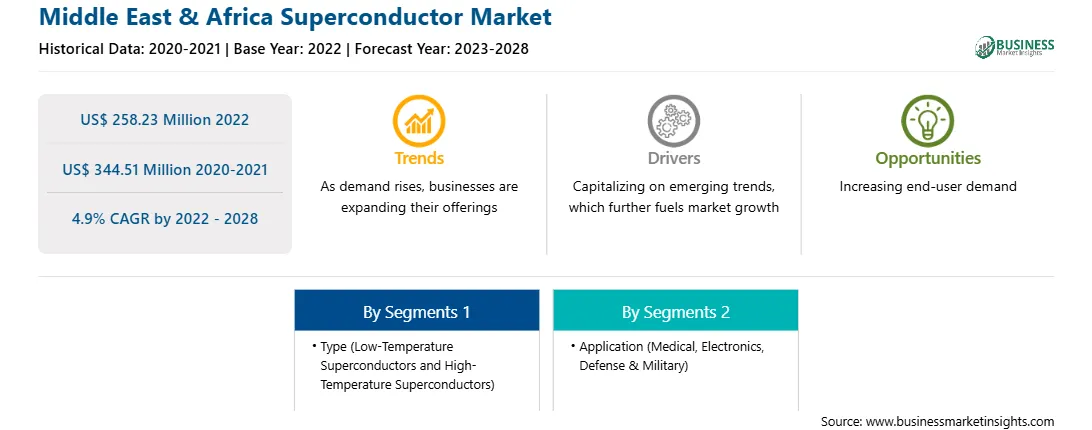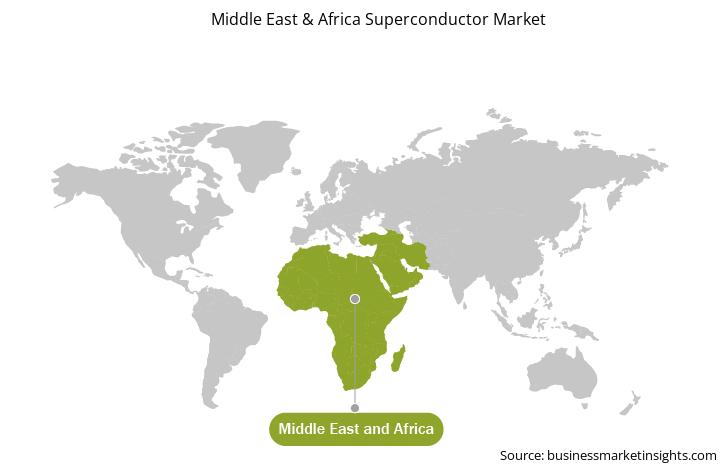The superconductor market in Middle East & Africa is expected to grow from US$ 258.23 million in 2022 to US$ 344.51 million by 2028. It is estimated to grow at a CAGR of 4.9% from 2022 to 2028.
Superconducting processors may become an essential component of the next generation of supercomputers. They could, for starters, assist in overcoming the major issue of scaling up quantum computers. Second, they might significantly improve the performance of classic supercomputers while drastically reducing their power usage. A multidisciplinary research initiative will address one of the primary obstacles of this approach, data transport to and from low temperatures required for superconductivity. A quantum computer's processing power is based on superconducting qubits that operate at extremely low temperatures. At room temperature, qubits are commonly operated by conventional electronics connected by electrical lines. When the number of qubits reaches the needed level of hundreds of thousands, the number of control cables becomes incapable of scaling up to match the number of qubits without causing an unacceptable heat load, thereby jeopardizing the quantum processor's low temperature.
One solution is to control the quantum processor with a nearby classical processor. The single flux quantum (SFQ) technology, which follows classical computer logic but employs superconducting technology instead of semiconductors, is the most promising answer. Due to its low-temperature requirements, SFQ has only been employed in a few classical computers. This disadvantage becomes a benefit when utilized in conjunction with superconducting quantum computers. Additionally, the extremely high-power consumption of CPUs and GPUs due to energy dissipation in silicon chips is a major restriction of supercomputers. In GPUs, replacing silicon chips with superconducting SFQ chips could significantly influence both performance and power consumption. Thus, the increase in superconducting chips to scale up quantum computers and supercomputers is driving the superconductors market.
With new features and technologies, vendors can attract new customers and expand their footprints in emerging markets. This factor is likely to drive the Middle East & Africa superconductor market at a substantial CAGR during the forecast period.
iddle East & Africa Superconductor Market Revenue and Forecast to 2028 (US$ Million)
Strategic insights for the Middle East & Africa Superconductor provides data-driven analysis of the industry landscape, including current trends, key players, and regional nuances. These insights offer actionable recommendations, enabling readers to differentiate themselves from competitors by identifying untapped segments or developing unique value propositions. Leveraging data analytics, these insights help industry players anticipate the market shifts, whether investors, manufacturers, or other stakeholders. A future-oriented perspective is essential, helping stakeholders anticipate market shifts and position themselves for long-term success in this dynamic region. Ultimately, effective strategic insights empower readers to make informed decisions that drive profitability and achieve their business objectives within the market. The geographic scope of the Middle East & Africa Superconductor refers to the specific areas in which a business operates and competes. Understanding local distinctions, such as diverse consumer preferences (e.g., demand for specific plug types or battery backup durations), varying economic conditions, and regulatory environments, is crucial for tailoring strategies to specific markets. Businesses can expand their reach by identifying underserved areas or adapting their offerings to meet local demands. A clear market focus allows for more effective resource allocation, targeted marketing campaigns, and better positioning against local competitors, ultimately driving growth in those targeted areas.
Middle East & Africa Superconductor Strategic Insights

Middle East & Africa Superconductor Report Scope
Report Attribute
Details
Market size in 2022
US$ 258.23 Million
Market Size by 2028
US$ 344.51 Million
Global CAGR (2022 - 2028)
4.9%
Historical Data
2020-2021
Forecast period
2023-2028
Segments Covered
By Type
By Application
Regions and Countries Covered
Middle East and Africa
Market leaders and key company profiles
Middle East & Africa Superconductor Regional Insights

Middle East & Africa Superconductor Market Segmentation
The Middle East & Africa superconductor market is segmented on the basis of type, application, and country. Based on type, the market is segmented into low-temperature superconductors and high-temperature superconductors. In 2022, the low-temperature superconductors segment held a larger market share. On the other hand, the high temperature superconductors are expected to register a higher CAGR during the forecast period.
Based on application, the market is segmented into medical, electronics, defense and military, and others. The medical segment held the largest market share in 2022 and is also expected to register the highest CAGR in the market during the forecast period.
Based on country, the market is segmented into South Africa, Saudi Arabia, the UAE, and the Rest of the MEA. In 2022, the UAE held a larger market share. On the other side, and Saudi Arabia is expected to register a higher CAGR during the forecast period.
American Superconductor; Bruker; FURUKAWA ELECTRIC CO., LTD.; Hitachi, Ltd.; Sumitomo Electric Industries, Ltd.; FUJI ELECTRIC CO., LTD.; Toshiba Corporation; and Cryomagnetics are among the leading companies in the Middle East & Africa superconductor market.
The Middle East & Africa Superconductor Market is valued at US$ 258.23 Million in 2022, it is projected to reach US$ 344.51 Million by 2028.
As per our report Middle East & Africa Superconductor Market, the market size is valued at US$ 258.23 Million in 2022, projecting it to reach US$ 344.51 Million by 2028. This translates to a CAGR of approximately 4.9% during the forecast period.
The Middle East & Africa Superconductor Market report typically cover these key segments-
The historic period, base year, and forecast period can vary slightly depending on the specific market research report. However, for the Middle East & Africa Superconductor Market report:
The Middle East & Africa Superconductor Market is populated by several key players, each contributing to its growth and innovation. Some of the major players include:
The Middle East & Africa Superconductor Market report is valuable for diverse stakeholders, including:
Essentially, anyone involved in or considering involvement in the Middle East & Africa Superconductor Market value chain can benefit from the information contained in a comprehensive market report.